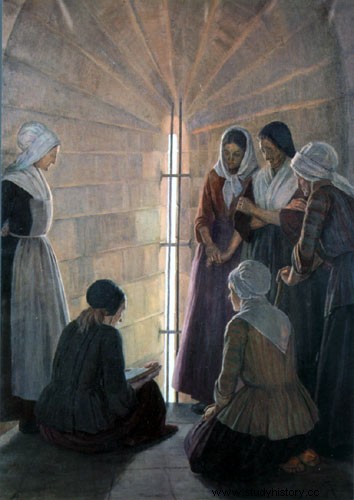
Who lived there? - Prisoners
Who put God before the king.
There, formerly, women, mothers,
Die to keep the faith. [1]
The Tower of Constance and its prisoners
While the men were condemned to the galleys, and the clandestine pastors to the stake, the women defying the prohibitions of the King of France were locked up in the Tour de Constance located in Aigues-Mortes. The origin of the name of the tower remains unknown, but it is assumed that it was erected in Roman times. Bordering the sea, it was a starting point for the Crusades. After the revocation of the Edict of Nantes in 1685, Protestants no longer had the right to practice their religion and were obliged to convert. Those who oppose it are threatened, oppressed, forced to abjure. Secret assemblies nevertheless continued to form, and it was when they were discovered that many Huguenots were severely punished. From 1692, the Tower welcomed men and women. The former are imprisoned on the ground floor, while the latter are locked up on the first floor. After the bloody camisard war at the beginning of the 18th century, only women remained there. If some give in and abjure, others refuse to submit, and support themselves among.
Their only crime was to have gone,
At night by a covered path,
Joining their voices to the assemblies
Who were praying God in the desert. [2]
These women tirelessly sing hymns, and make their united voices resound between the walls that hold them prisoner. Sometimes allowed to access the outside by climbing to the top of the Tower, they take a breath of fresh air on the terrace, facing the sea from where the galleys depart, before returning inside. The Tower is located near Protestant villages which experienced revolts by rebellious Huguenots. The prisoners remain cloistered for years, and even decades, resisting the temptation to abjure. Indeed, they would only have to convert and sign to be released. However, some will spend their lives there. In 1768, fourteen women were prisoners there when the new governor of Languedoc decided to grant them their freedom.
Ah, never will these gray walls
Will repeat what we suffered
These peasant women, these marquises,
These noble girls of the desert ! [3]
Marie Durand:emblematic prisoner
Marie Durand, arrested and imprisoned at the age of nineteen, did not leave the Tower until the age of fifty-seven. Sister of pastor Pierre Durand, Marie is destined to marry Matthieu Serres when the king's soldiers come to arrest her at her home. His brother, who chaired a clandestine assembly, managed to escape and is actively sought by the authorities of the region. In order for him to surrender, the soldiers arrest his family members one by one. While her husband was taken to Fort de Brescou, Marie Durand prepared to spend thirty-eight years of her life in the Tour de Constance, from 1730 to 1768. She was the prisoner best known for the tenacity of her faith. The inscription "Register", engraved in a stone of the Tower, is attributed to him.
But in their faith drawing a balm,
In a voice trembling with tears,
Together they sang a psalm...
Broken hearts are big hearts. [4]
